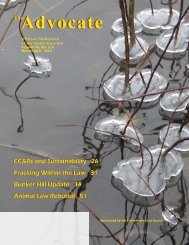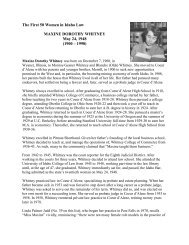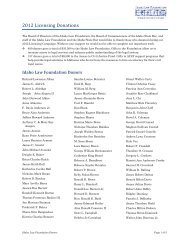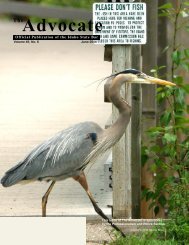The Advocate - May 2012 - Idaho State Bar - Idaho.gov
The Advocate - May 2012 - Idaho State Bar - Idaho.gov
The Advocate - May 2012 - Idaho State Bar - Idaho.gov
You also want an ePaper? Increase the reach of your titles
YUMPU automatically turns print PDFs into web optimized ePapers that Google loves.
no n t r a d i t i o n a l la W st u d e n t s: a 21 s t Ce n t u ry re s o u r C e<br />
Donna Emert<br />
University of <strong>Idaho</strong><br />
College of Law<br />
Growing ranks of nontraditional<br />
law students present<br />
new opportunities and new<br />
challenges for law schools<br />
nationwide. <strong>The</strong> first challenge<br />
is defining them.<br />
“<strong>The</strong> way we think of the traditional<br />
student is one who attends school from<br />
kindergarten through juris doctorate, is<br />
unmarried, has no children, is attending<br />
law school full time, and probably is not<br />
doing much work outside of academia,”<br />
said Lee Dillion, University of <strong>Idaho</strong><br />
College of Law associate dean for Boise<br />
programs.<br />
Nontraditional students include all<br />
who do not fit neatly within those parameters,<br />
including students who are older,<br />
married, have children, are entering law<br />
school from the workforce or are full<br />
time students who simultaneously hold<br />
a job up to 20 hours per week, the maximum<br />
allowed by the American <strong>Bar</strong> Association<br />
for students taking 12 or more<br />
credit hours per semester.<br />
Dillion, like several University of<br />
<strong>Idaho</strong> College of Law faculty and staff,<br />
was a nontraditional student himself.<br />
“When I took my daughter to campus<br />
in the late 1970s, it was kind of like<br />
a petting zoo:<br />
the reaction<br />
was ‘look at the<br />
strange creature<br />
you’ve brought!’”<br />
Dillion recalls<br />
with a laugh.<br />
“<strong>The</strong>re were not<br />
many married students<br />
or students<br />
with children.<br />
Since then law<br />
schools generally,<br />
and ours particu-<br />
54 <strong>The</strong> <strong>Advocate</strong> • <strong>May</strong> <strong>2012</strong><br />
Donna Emert<br />
larly, have done a good job addressing<br />
the needs of non-traditional students.”<br />
A significant number of University<br />
of <strong>Idaho</strong> law students are married, have<br />
children, or are nontraditional in other<br />
ways.<br />
“Every Monday morning I come in to<br />
the law school and see little hand prints<br />
and face prints on our glass door,” said<br />
Dillion, citing one smudgy barometer of<br />
change for law students raising families.<br />
“<strong>The</strong> spouses often come down here and<br />
interact. We’ve created a pretty friendly<br />
atmosphere that I certainly didn’t feel<br />
when I went to law school.”<br />
For both traditional and nontraditional<br />
students, time management remains<br />
one of the greatest obstacles in<br />
law school. Non-traditional students may<br />
have an edge over K-through-JD students<br />
there, Dillion suggests: “Non-traditional<br />
students often treat law school like a job:<br />
they’re working eight to five. <strong>The</strong>y have<br />
more time pressures, but they’re experienced,<br />
and often better, time managers.”<br />
On the down-side, nontraditional<br />
students’ fuller schedules can mean less<br />
time to get involved in the University’s<br />
diverse clinical programs, externships,<br />
internships, assistantships, publications<br />
and competitions. <strong>The</strong>se experiences are<br />
designed to wed theory and application.<br />
<strong>The</strong> vast majority of nontraditional<br />
students do take advantage of these onthe-ground<br />
experiences. A third-year law<br />
student in Moscow, Erin Hodgin-Tomlin,<br />
has engaged in extra-curricular activities<br />
that have included co-chairing the Native<br />
American Law Students Association,<br />
participating in the D. Craig Lewis Trial<br />
Team, and serving as the law school’s<br />
volunteer representative on the Latah<br />
County Youth Accountability Board — a<br />
diversion program for first-time juvenile<br />
offenders. In addition she has volun-<br />
Photo by Donna Emert<br />
university of <strong>Idaho</strong> Law Associate Dean Lee Dillion talks with third-year law student Jeff<br />
Butler about juggling school and family.<br />
“Non-traditional students<br />
often treat law school<br />
like a job: they’re<br />
working eight to five.<br />
<strong>The</strong>y have more time<br />
pressures, but they’re<br />
experienced, and often<br />
better, time managers.”<br />
– Lee Dillion<br />
teered at Latah County’s Small Claims<br />
Court as a mediator, and has logged more<br />
than 150 hours in pro-bono service as a<br />
law student.<br />
Hodgin-Tomlin also has worked<br />
part-time as a research assistant for a law<br />
professor, and part-time for a local public<br />
defender, handling misdemeanors and<br />
representing clients in court, within the<br />
parameters of her limited license.<br />
In between and throughout, she and









